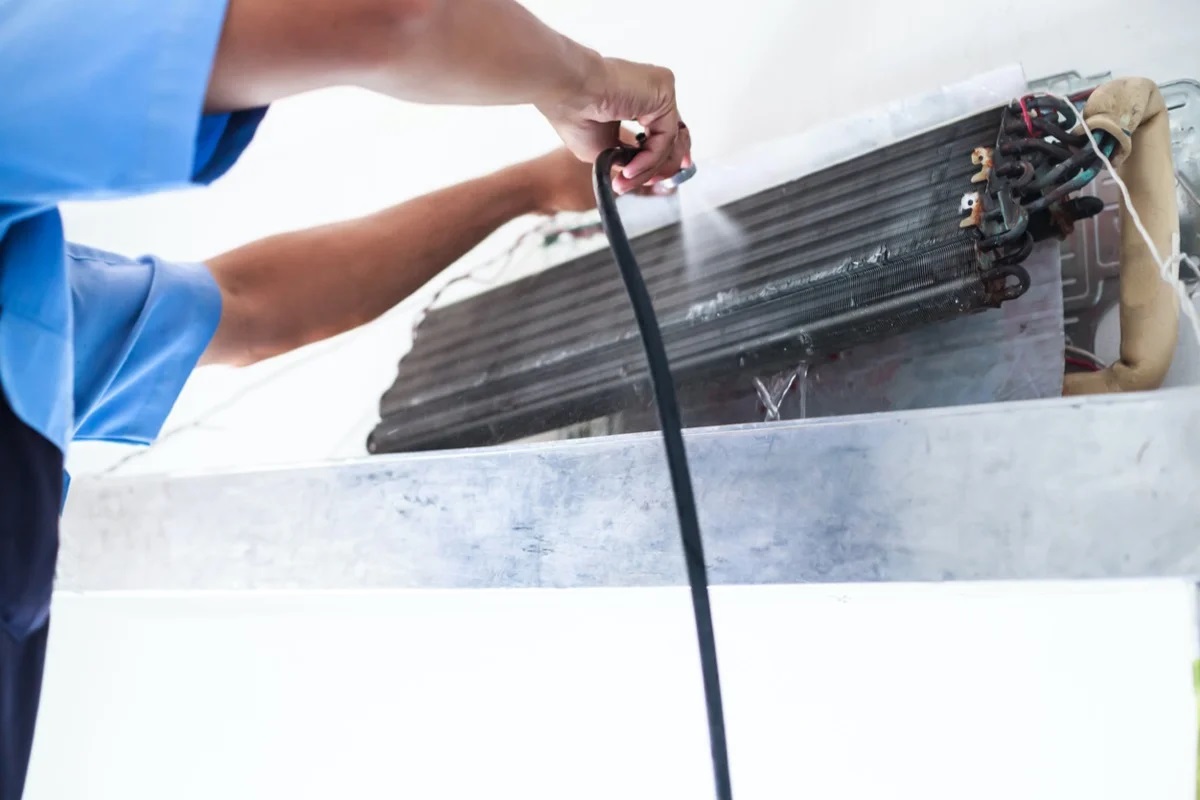Historical Use of Asbestos in Construction
Asbestos has a long history in construction due to its durability and resistance to heat. From the early 20th century until the late 1970s, it was widely used in building materials. Many older tool sheds might still contain asbestos in various forms. This mineral was favored for its insulating properties and was commonly found in roofing, siding, and insulation materials. However, as awareness about its health risks grew, regulations began to limit its use.
Common Asbestos-Containing Materials
In tool sheds, asbestos can be present in several materials. These include:
- Roofing shingles and siding
- Insulation used for pipes and walls
- Cement sheets and panels
These materials were chosen for their fire-resistant qualities, but they pose significant health risks if disturbed.
Health Risks Associated with Asbestos
When asbestos fibers are inhaled, they can cause severe health issues. The fibers can lodge in lung tissue, leading to inflammation and scarring over time. Prolonged exposure can result in diseases such as asbestosis, lung cancer, and mesothelioma. Homeowners should be aware of these risks, especially if their sheds contain materials from the era when asbestos was commonly used. Proper handling and, if necessary, professional removal are crucial to prevent exposure.
Identifying Asbestos in Your Tool Shed
Visual Indicators of Asbestos Presence
When trying to figure out if your tool shed might have asbestos, you can’t just rely on looks. Asbestos fibers are super tiny and not visible to the naked eye. However, there are some things you can look for that might hint at its presence. Old materials, especially those installed before the 1980s, are suspect. You might find asbestos in insulation, roofing, or old cement sheets. These materials often look worn, like they’re breaking down, or have a fibrous texture. Asbestos cement sheets usually start as grey or off-white and weather to a dull, textured surface over time due to environmental exposure. Identifying these characteristics can help determine if a garage roof contains asbestos.
Common Locations for Asbestos in Sheds
Asbestos was a popular choice in construction because it was cheap and fire-resistant. In tool sheds, you might find it in:
- Roofing materials: Asbestos was commonly used in roofing because of its durability.
- Insulation: If your shed has any old insulation, it might contain asbestos.
- Wall panels and flooring: Cement sheets and vinyl flooring from the past often have asbestos.
Checking these spots can give you a better idea if asbestos is lurking in your shed.
Tools for Asbestos Detection
If you’re worried about asbestos, there are ways to test for it. DIY asbestos testing kits are available, but they come with risks. These kits involve taking a sample of the suspect material and sending it to a lab for analysis. It’s a cheaper option, but handling asbestos without proper gear can be dangerous. For a more secure approach, hiring a professional to conduct the testing is recommended. They have the right equipment and expertise to safely collect samples and interpret the results. Whether you go DIY or professional, knowing what’s in your shed can help you make informed decisions about safety and renovations.
Health Risks of Asbestos Exposure
Respiratory Diseases Linked to Asbestos
Asbestos exposure is a serious health issue due to its link to several respiratory diseases. When asbestos fibers are inhaled, they can lodge deep within the lungs. Over time, this can lead to conditions such as asbestosis, lung cancer, and mesothelioma. There is no safe level of exposure to asbestos, making it crucial to minimize contact with this hazardous material. Asbestosis, for example, causes chronic inflammation and scarring of lung tissue, leading to severe respiratory problems. Mesothelioma, a rare cancer affecting the lining of the lungs, is almost exclusively caused by asbestos exposure. Short-term exposure to asbestos dust can also be dangerous, potentially causing symptoms like chest pain and shortness of breath, although these might not immediately indicate long-term health issues.
Long-Term Health Implications
The long-term health implications of asbestos exposure are severe and often life-threatening. It can take decades for symptoms to appear, making early detection difficult. Asbestos-related diseases can include:
- Asbestosis: This condition causes irreversible lung damage and increases the risk of other respiratory illnesses.
- Lung Cancer: The risk of developing lung cancer is significantly higher for individuals who have been exposed to asbestos, particularly if they are smokers.
- Mesothelioma: This aggressive cancer affects the lining of the lungs and abdomen and is typically diagnosed at an advanced stage.
These conditions are not only debilitating but often fatal, underscoring the importance of avoiding asbestos exposure.
Preventive Measures for Homeowners
To protect against the health risks associated with asbestos, homeowners should take several preventive measures:
- Identify Potential Asbestos Sources: Be aware of common asbestos-containing materials in the home, such as old insulation, floor tiles, and roofing materials.
- Avoid Disturbing Suspected Asbestos: If you suspect a material contains asbestos, do not disturb it. Disturbing asbestos materials can release fibers into the air.
- Consult Professionals: If asbestos is suspected, consult with a professional for testing and removal. Professional services ensure that asbestos is handled safely and in compliance with regulations.
By taking these steps, homeowners can significantly reduce the risk of asbestos exposure and protect their health and the health of their families. Remember, asbestos exposure can cause serious health issues, so vigilance and caution are key.
Legal and Safety Guidelines for Asbestos Handling
Regulations on Asbestos Use and Removal
Handling asbestos isn’t just about safety—it’s about following the law. Regulations are in place to protect both workers and the public from the dangers of asbestos exposure. In many places, you need to inform local authorities before starting any asbestos removal project. Permits might be required, and there could be fees involved. Many companies offer to handle this paperwork for you, which can be a relief if you’re not familiar with the legal requirements.
Safety Protocols for Handling Asbestos
When dealing with asbestos, safety protocols are non-negotiable. Here’s a basic list to ensure safety:
- Personal Protective Equipment (PPE): Always wear the right gear, including a P1 or P2 respirator, boot covers, hooded coveralls, eye protection, and gloves.
- Work Area Preparation: Line the area with plastic sheets and keep asbestos surfaces damp to reduce fiber spread.
- Waste Management: Clearly label all asbestos waste and consult with local councils or hire an approved contractor for disposal.
Licensing Requirements for Asbestos Removal
Removing asbestos isn’t a DIY job. In most regions, only licensed professionals are allowed to perform this task. This is because improper handling can lead to serious health risks, including respiratory diseases. If you suspect asbestos in your home, it’s crucial to hire a certified expert who knows the regulations and safety procedures. Hiring a professional ensures that the job is done safely and legally, minimizing the risk of exposure.
For more details on the safe handling and disposal of asbestos, check out this resource.
Testing for Asbestos in Home Tool Sheds
DIY Asbestos Testing Kits
Homeowners often consider using DIY asbestos test kits to determine the presence of asbestos in their tool sheds. These kits are readily available and allow individuals to collect samples themselves. The process involves three main steps: collecting the sample, packaging it securely, and sending it to a lab for analysis. It’s crucial to follow the instructions carefully to ensure accurate results. Safety precautions should never be overlooked; using protective gear like gloves and masks is essential to avoid exposure. DIY kits can be a practical choice for those who want to save on professional testing fees.
Professional Asbestos Testing Services
For a more comprehensive assessment, hiring professional asbestos testing services might be the best route. These experts have the necessary tools and expertise to accurately identify asbestos-containing materials. They conduct thorough inspections and utilize advanced techniques to ensure reliable results. While this option is more costly, it provides peace of mind, especially if the asbestos presence is uncertain. Professionals can also advise on the next steps if asbestos is detected, ensuring that you handle the situation safely and legally.
Interpreting Test Results
Once the testing is complete, understanding the results is vital. If asbestos is present, homeowners must decide on the appropriate course of action. This might involve consulting with specialists to discuss removal or encapsulation options. It’s important to remember that testing for asbestos is typically unnecessary if building materials are in good condition and no home remodeling is planned. However, if results indicate the presence of asbestos, immediate measures should be taken to prevent exposure. Additionally, regular inspections and maintenance can help manage any potential risks effectively.
Steps to Take if Asbestos is Found
Immediate Actions to Ensure Safety
Finding asbestos in your tool shed can be unsettling, but the first step is to stay calm and act cautiously. If the asbestos material is intact and not disturbed, it may not pose an immediate risk. However, if the material is damaged or friable, it’s crucial to limit access to the area to prevent exposure.
- Restrict Access: Keep children and pets away from the shed until the situation is assessed.
- Avoid Disturbance: Do not attempt to clean or remove the material yourself, as this can release asbestos fibers into the air.
- Seal the Area: If possible, seal off the area with plastic sheeting to contain any potential fibers.
Consulting with Asbestos Professionals
Once the immediate area is secured, the next step is to consult with a professional. Hiring a licensed asbestos inspector can provide a thorough assessment of the situation. These experts can safely collect samples and determine the extent of asbestos presence.
- Professional Assessment: A certified inspector will analyze the materials and advise on the best course of action.
- Legal Guidance: Professionals can also inform you of any legal requirements, such as notifying the EPA or local authorities about the asbestos discovery.
- Safety Recommendations: They will offer guidance on whether the asbestos should be left undisturbed, encapsulated, or removed.
Planning for Asbestos Removal
If removal is necessary, it’s important to plan carefully. Asbestos removal is a complex process that should only be handled by certified professionals.
- Hire Licensed Contractors: Ensure the contractors are licensed and experienced in asbestos abatement. This ensures compliance with safety standards and regulations.
- Understand the Process: Discuss the removal process with the contractor, including the methods they will use and the timeline for the project.
- Prepare for Disposal: Proper disposal of asbestos materials is critical. Contractors should provide a disposal manifest to confirm that the materials have been handled in accordance with regulations.
In some cases, encapsulation might be recommended as a temporary solution if the asbestos is in good condition and not likely to be disturbed. This involves sealing the material to prevent fiber release. However, if future renovations are planned, full removal might be necessary to ensure long-term safety.
Asbestos Removal and Abatement Options
Encapsulation vs. Removal
When dealing with asbestos, homeowners often face the choice between encapsulation and removal. Encapsulation involves applying a sealant to asbestos-containing materials, effectively binding the fibers and preventing them from becoming airborne. This method is often used for materials that are in good condition and unlikely to be disturbed. While encapsulation can be a cost-effective solution, it’s not a permanent fix. If the encapsulated materials are later damaged, removal may still be necessary.
On the other hand, removal is the process of entirely eliminating asbestos from the premises. This is often the preferred option when the asbestos is damaged, friable, or in an area prone to disturbance. Removal is more expensive and complex but offers a permanent solution to asbestos exposure risks.
Hiring Certified Asbestos Abatement Contractors
Choosing the right professional for asbestos removal is crucial. Hiring licensed asbestos abatement professionals ensures that the job is done safely and in compliance with regulations. When selecting a contractor, consider asking the following questions:
- Can you provide proof of a state asbestos abatement license?
- Do you have liability and workers’ compensation insurance?
- What is your experience with projects similar to mine?
- Can you outline the safety measures you’ll implement?
- How will you handle asbestos disposal?
It’s also wise to check customer reviews and seek recommendations from trusted sources. Ensuring that air quality testing is part of the contract can provide peace of mind.
Cost Considerations for Asbestos Removal
The cost of asbestos removal can vary widely depending on several factors. Initial inspection and testing can range from $231 to $780, influenced by the size of the property and the number of samples required. Removal expenses themselves can be significant, typically costing between $1,192 and $3,254 per square foot, depending on the material’s location and the complexity of the removal process.
Disposal fees also add to the total cost, with permits and waste disposal charges ranging from $50 to $100 for a disposal permit and an additional $10 to $50 per cubic yard of waste. Understanding these cost factors can help homeowners budget effectively for asbestos abatement.
Preventing Asbestos Exposure During Renovations
Safe Renovation Practices
Renovating a home, especially one built before the 1980s, can pose significant risks if asbestos is present. Ensuring safety during renovations is crucial to prevent asbestos exposure. Here’s how to navigate this potentially hazardous situation:
- Identify Asbestos Materials: Before starting any renovation, identify materials that may contain asbestos. This includes insulation, floor tiles, and roofing materials.
- Limit Disturbance: Avoid disturbing any materials that might contain asbestos. If you suspect asbestos, stop work immediately and consult a professional.
- Use Proper Equipment: Equip yourself with the necessary tools and protective gear to minimize exposure.
Identifying Asbestos Before Renovation
Before diving into renovations, it’s essential to know where asbestos might be hiding. Asbestos is often found in older construction materials. Here’s where you might find it:
- Insulation: Often used in attics and around pipes.
- Flooring: Vinyl tiles and adhesive used in flooring can contain asbestos.
- Roofing Materials: Shingles and roofing felt may also harbor asbestos fibers.
Protective Equipment for Renovation
When dealing with asbestos, personal protective equipment (PPE) is your first line of defense. Wearing the right gear can significantly reduce the risk of exposure. Consider the following:
- Respirators: Use a P2/N95 respirator to avoid inhaling asbestos fibers.
- Disposable Overalls: Wear disposable coveralls to prevent fibers from clinging to your clothes.
- Gloves and Eye Protection: Ensure you have gloves and eye protection to shield yourself from harmful particles.
By following these guidelines, homeowners can significantly reduce the risk of asbestos exposure during renovations, keeping themselves and their families safe.
Maintaining a Safe Environment in Tool Sheds
Regular Inspections for Asbestos
Keeping your tool shed safe starts with regular inspections. It’s important to check for any signs of asbestos materials, especially in older structures. Look for materials that might contain asbestos, like insulation or old flooring. Make a habit of inspecting these areas at least twice a year. If you’re unsure about what to look for, consider hiring a professional to conduct a thorough inspection.
Proper Ventilation and Air Quality
Good ventilation is key to maintaining a safe environment in your shed. Proper airflow helps reduce the concentration of any harmful particles, including asbestos fibers. Install vents or fans to ensure air circulates well. It’s also wise to use air quality monitors to detect any potential issues early. Maintaining proper barriers and ventilation can significantly minimize health risks.
Educating Family Members on Asbestos Risks
Everyone in the household should be aware of the potential risks of asbestos. Educate your family about the dangers and signs of asbestos exposure. Discuss the importance of not disturbing any suspicious materials and the steps to take if asbestos is suspected. Providing this knowledge can prevent accidental exposure and ensure everyone knows how to respond appropriately. Additionally, wearing protective gear during any maintenance or cleaning can add an extra layer of safety.
Alternatives to Asbestos in Construction
Modern Materials Replacing Asbestos
In recent years, the construction industry has moved away from asbestos due to its health risks. Safer alternatives now provide the same durability without the dangers. For instance, cellulose fiber insulation is gaining popularity. Made from recycled paper, it’s treated for fire resistance and offers excellent thermal insulation. Fiberglass is another option, known for its strength and resistance to moisture. These materials not only replace asbestos but also improve overall building safety.
Benefits of Asbestos-Free Products
Choosing asbestos-free products comes with numerous benefits. Firstly, they significantly reduce health risks associated with asbestos exposure. Secondly, they are more environmentally friendly, as many are made from recycled materials. Lastly, these products tend to be easier to handle and install, reducing labor costs and time.
Environmental Impact of Asbestos Alternatives
The shift to asbestos alternatives is not just about health; it’s also about the environment. Polyurethane foam, for example, offers excellent insulation properties while being more sustainable. Amorphous silica fabrics are another alternative that provides durability without the environmental footprint of asbestos. By opting for these materials, builders contribute to a healthier planet while ensuring safer construction practices.
More Resources




